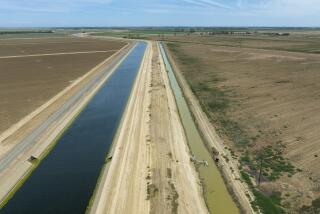Big water users, take note: DWP is considering outing you

Last week, famed Oakland Athletics executive Billy Beane, a Danville resident, apologized for wasting water after his excessive use was made public by the East Bay Municipal Utility District.
Decades before someone coined the Twitter hashtag #droughtshaming and people began posting YouTube videos of their neighborsâ drowning lawns, California water suppliers encouraged conservation by releasing the names of their biggest water hogs.
Among these wealthy and powerful water guzzlers was then-San Diego Union-Tribune publisher Helen Copley, who often saturated her La Jolla property with more than 10,000 gallons a day. âI donât doubt for one minute that I might be the biggest user,â she told The Times in 1991.
Things are different today.
As California struggles through its worst dry spell on record, water providers such as the Los Angeles Department of Water and Power have refused to divulge the names of Californiaâs top residential water users, including one Bel-Air household that consumed 11.8 million gallons of water in a year â more than 90 times that of an average household.
Even though the DWP calls such conspicuous consumption âa shameful waste of precious drinking water,â changes made to the California Public Records Act after the last major drought bar the release of customer information, officials and public information advocates say.
âThe people who were at risk of being shamed were wealthy and had some political clout,â said Peter Scheer, executive director of the San Rafael-based First Amendment Coalition. âSome of them were undoubtedly behind amending the public records law.â
In response to public outrage, and questioning by Los Angeles City Councilman Paul Koretz, the DWP is now considering changes to its water conservation ordinance that would impose âsubstantialâ fines for excessive use and make the names public.
One Bay Area water agency did just that in April, adopting an excessive-use penalty ordinance that allows it to fine and name water customers who consume more than four times the average household.
Last week, famed Oakland Athletics executive Billy Beane, a Danville resident, apologized for wasting water after his excessive use was made public by the East Bay Municipal Utility District. Beane, the subject of the book and film âMoneyball,â blamed his plight on leaky irrigation pipes and told the Associated Press that the problem has been corrected.
Although some water policy analysts argue that public disclosure of heavy water use can encourage conservation, lawmakers, municipal groups and others argued in 1997 that the public release of customer information posed a safety risk. In arguing to change the California Public Records Act, they invoked the 1989 slaying of actress Rebecca Schaeffer, who was shot by a stalker who obtained her address through public motor vehicle records.
The practice of concealing the identities of a water agencyâs largest residential customers is by no means universal. In Nevada, which is also struggling with drought, water agencies can provide this information in response to a federal Freedom of Information Act request, according to a spokesman with the Southern Nevada Water Authority.
The issue of unidentified residential âmega-usersâ in California was detailed in a report published earlier this month by the Center for Investigative Reporting. It found that 365 California households each consumed more than 1 million gallons of water from April 2014 to April 2015.
Of those, four of the top 10 water consumers were located in Bel-Air.
The DWP, and other water agencies, have refused to name these customers, saying they are not required to by law. The agency also argues that since private utilities are not subject to the California Public Records Act, âLADWP customers should not have a lesser right of privacy since they are serviced by a public utility.â
Asked whether the DWP had spoken with the Bel-Air mega-users, agency spokeswoman Michelle Figueroa said in a statement that the agency had âreached out to these customers last spring in writing and will continue to do so again with personal visits and in writing.â
Tracy Quinn, a water efficiency expert with the Natural Resources Defense Council, said it was hard to believe that wealthy mega-users were actually going to the mailbox and reading the DWPâs notices.
âPrivacy is always a concern, but sunshine is a great disinfectant,â Quinn said. âPublic shaming, or highlighting some of this egregious water use in times of drought, has been an effective tool to lower usage.â
Quinn noted the case of Barbra Streisand, who reportedly vowed to slash her water use after an airborne photographer took photos of verdant landscaping at her Malibu compound.
For the vast majority of Californians, outdoor water use is hard to conceal, and many residents are encouraged to report incidents of excessive use through smartphone apps or on water agency websites. In the case of extremely wealthy residents, however, outdoor water use often occurs behind tall gates, away from public scrutiny.
Although the Public Records Act does not permit water agencies to release customer information on usage, there is an exception. A subsection of the law requires disclosure when a customer âhas used utility services in a manner inconsistent with local utility usage policies.â
It was under this subsection of the law that the East Bay water agency released information on excessive use violators, according to agency spokeswoman Abby Figueroa.
The agency made public the names of 1,100 violators last week after media outlets requested the information. Figueroa said that this was only a partial list, and that more would be released as the agency continues its billing and meter-reading process.
Agency officials insisted that they were not trying to embarrass customers for their heavy water use and were simply complying with the law.
âDrought shaming is not the intention,â the East Bay water agencyâs Figueroa said of the ordinance. âWater conservation is the goal.⦠We hope that this serves as a wake-up call to our highest users. They have a lot to cut back.â
Twitter: @montemorin
ALSO
Lopez: Drought posse searching for Bel Airâs biggest water waster
Lopez: DWP should follow Bay Area utilityâs lead and out its water hogs
$68-billion California bullet train likely to overshoot budget, deadlines
More to Read
Sign up for Essential California
The most important California stories and recommendations in your inbox every morning.
You may occasionally receive promotional content from the Los Angeles Times.











